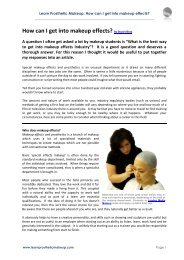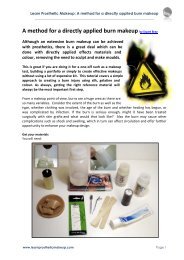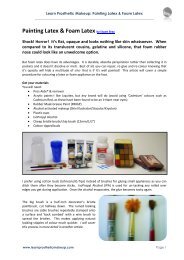Working within makeup effects: an overview by Stuart Bray - Learn ...
Working within makeup effects: an overview by Stuart Bray - Learn ...
Working within makeup effects: an overview by Stuart Bray - Learn ...
You also want an ePaper? Increase the reach of your titles
YUMPU automatically turns print PDFs into web optimized ePapers that Google loves.
<strong>Learn</strong> Prosthetic Makeup: <strong>Working</strong> <strong>within</strong> <strong>makeup</strong> <strong>effects</strong>: <strong>an</strong> <strong>overview</strong><br />
________________________________________________________________<br />
Sculpting<br />
Sculpting is <strong>an</strong> essential part of the<br />
department, <strong>an</strong>d whether it’s <strong>an</strong><br />
ear tip to turn Spock into a Vulc<strong>an</strong>,<br />
a whole body ‘creature-suit’ to<br />
make Hellboy look fearsome or a<br />
battlefield of bloodied corpses on<br />
Omaha beach, ch<strong>an</strong>ces are there<br />
has been some kind of sculpture<br />
involved.<br />
Martin Rezard sculpts a Minotaur maquette in plasteline<br />
for Inkheart (2008) for Millennium FX.<br />
The scale of sculpting c<strong>an</strong> vary<br />
enormously from subtle prosthetic appli<strong>an</strong>ces which need to have pore perfect<br />
detail, to huge oversized creatures which may require a whole team of<br />
sculptors. Ideas <strong>an</strong>d designs may be sketched out on paper or made as<br />
‘maquettes’-small scale versions which c<strong>an</strong> show the producers the idea<br />
without the materials <strong>an</strong>d cost involved in a full size version.<br />
Full sized eleph<strong>an</strong>t ‘stunt trunk’<br />
sculpt in clay for ‘Alex<strong>an</strong>der’<br />
(2004).<br />
Sculpt <strong>by</strong> <strong>Stuart</strong> <strong>Bray</strong> & Waldo<br />
Mason. For Neil Courbold FX.<br />
Sculpting commercially like this is as much<br />
pragmatic problem solving as it is creative.<br />
There is rarely time to indulge the artistic urges<br />
m<strong>an</strong>y sculptors have, as this is only one aspect<br />
of the process. Once you have your sculpted<br />
form, you then need to make <strong>an</strong> object from<br />
it which c<strong>an</strong> be used during filming<br />
New technologies me<strong>an</strong> digital models c<strong>an</strong> be sculpted too, either as a<br />
design tool to simply show concepts or to create the final version. Sculpting<br />
software such as ZBrush, Mudbox <strong>an</strong>d modo are used to create virtual<br />
models which c<strong>an</strong> later be output in a lightweight material for moulding<br />
without the need for clay-useful where massive sculptures would<br />
need literally tons of material.<br />
Sculptor Martin Rezard used ZBrush<br />
to create this classically themed bust.<br />
Even with computers, the sculptor still needs to underst<strong>an</strong>d form <strong>an</strong>d<br />
shape in order to create convincing work (after all, simply having a<br />
word processor does not make you a novelist). Doing it this way c<strong>an</strong> save<br />
time <strong>an</strong>d money, allowing for m<strong>an</strong>y more variations of design before committing to a final concept.<br />
Moulding & casting<br />
Once you have your sculpture, you need to<br />
reproduce it in <strong>an</strong> appropriate material. You sculpt<br />
<strong>an</strong> original form in clay because it’s <strong>an</strong> easy material<br />
to push around <strong>an</strong>d work to your intended shape.<br />
Once you have that form, you then need to make a<br />
mould so that you c<strong>an</strong> make rubber versions.<br />
Anything which is made from a mould is known as a<br />
‘cast’, <strong>an</strong>d care must be taken to ensure that each<br />
cast is useable.<br />
Good moulding is essential, as once the mould is<br />
made your original sculpture is usually ruined in the<br />
The eleph<strong>an</strong>t trunk has<br />
been sprayed with a<br />
silver waterproof sealer<br />
to prevent the clay from<br />
drying out.<br />
Clay walls are added to<br />
enable the mould to be<br />
made in a number of<br />
sections. The various<br />
pieces will then fit<br />
together perfectly,<br />
allowing easy removal of<br />
the casts.<br />
Large moulds such as<br />
this need to be both<br />
strong <strong>an</strong>d lightweight.<br />
Fibreglass is often used<br />
in this inst<strong>an</strong>ce.<br />
www.learnprosthetic<strong>makeup</strong>.com Page 2









